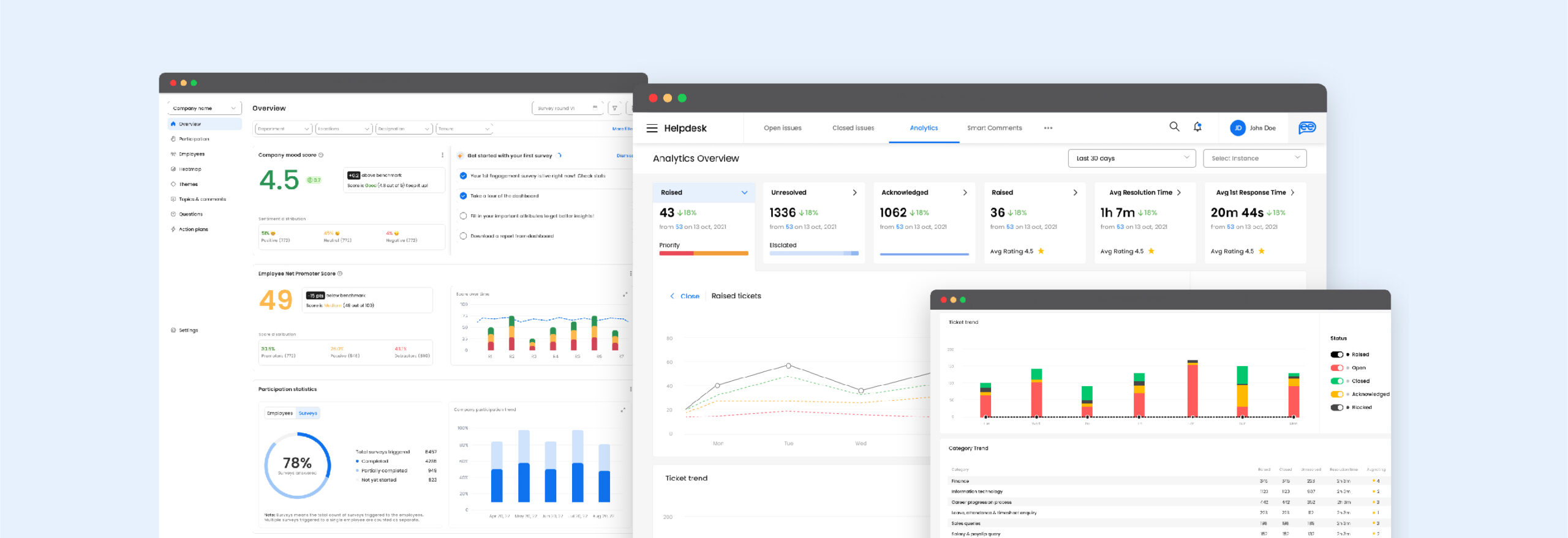HR’s role in employee engagement is as necessary and critical as the role of an inspiring leader in an organization.
HR and employee engagement are closely linked, as HR is responsible for creating an environment that supports and fosters employee engagement, while employee engagement is essential for the overall success and performance of the organization.

HR professionals also work to resolve conflicts and address any issues that may be impacting employee engagement. By effectively managing employee engagement, HR professionals can help to improve productivity, reduce turnover, and foster a positive corporate culture.
The HR’s role in employee engagement is evidently the most critical one. Now let’s understand, how does hr impact employee engagement with the help of some impactful engagement strategies.
What are some HR strategies to improve employee engagement?

While there are many ways to drive employee engagement at an organization, there are a few HR strategies to increase employee engagement and they go a long way in creating a positive impact at work.
1. Build an engagement strategy through active analysis
Data from Work Institute’s 2017 Retention Report estimates that it costs as much as 33% of a worker’s annual salary to replace. It shows that recognizing employee engagement as a strategic priority is the need of the hour for every company to succeed in this cut-throat competition.
Earlier, employee engagement was limited to annual activities and surveys. However, companies are now investing more time, energy, and resources to create more proactive employee engagement opportunities.
To do this, you need to start by actively analyzing your employees’ engagement levels, their goals and objectives, and the challenges they face. Identifying the nuances that could be taking their interest away from work is essential.
To accurately analyze employee engagement levels, HRs can invest in an intelligent AI-powered engagement platform backed by technologies like machine learning and natural language processing. Such tools offer real time insights to employee moods and sentiments allowing HRs to build engagement action plans in time.
2. Implement automation to remove redundancy

Another way to strengthen HR’s role in employee engagement is by eliminating manual handling of employee inquiries. If the HR team is constantly busy in resolving monotonous employee queries and answering simple questions, how will they make time for creating strategy based action plans?
Similarly, if employees feel that their HR department is only limited to answering simple questions, they might not feel comfortable sharing any important concerns that might be causing disengagement.
Additionally, employees these days expect their daily office inquiries to be resolved as quickly and easily as they expect it from their shopping app or food app. Therefore, tools that automate business processes are essential as you steadily increase your employee engagement efforts.
HR automation software eliminates the need for handling repetitive, tedious tasks that many HR professionals find frustrating. It creates an opportunity for HRs to focus their time and energy on more strategy based tasks.
But to get the best results, you need to invest in a tool that can accurately streamline the mundane HR processes. From employee helpdesks to analytics, Leena AI’s process automation will take care of it all and help revolutionize your company’s HR operations.
3. Maintain regular communication with employees
Transparency and communication are the foundations for bettering the HR’s role in employee engagement. The core of maintaining productivity and strong working relationships at all levels of an organization is periodic and transparent communication.
Highly engaged organizations prioritizing face time between HR managers and employees can boost employee morale and take care of issues before they escalate.
Communication plays a prominent role in employee engagement and satisfaction. You can use the following approaches to build a culture of regular and clear communication with employees:
- One-on-one meetings
- All-company meetings
- Emails from leadership
- Team or department meetings
- Exit interviews
- Employee engagement surveys
- Performance reviews or conversations
- Social media interactions
- Leadership roundtables
4. Set clear expectations
The most critical part about HR’s role in employee engagement is to set and maintain employee expectations. The core of most workplace miscommunication is that the expectations did not clearly lay out in the first place. So, employees often don’t fully understand what to do, why they should invest time in it, and what impact it has on the organization.
Remember that it’s always a good practice to ensure complete alignment of employees to their job roles and responsibilities. Assuming that employees already know or will figure it out themselves results in disengaged and directionless efforts, resulting in more frustration in the workplace.
While onboarding, explain to the recruits what a typical day in the office looks like, what is expected of them, and how specific departments operate. To make your employee onboarding experience memorable, you can automate onboarding process using an AI-powered employee onboarding software and build a tailored journey for each of the new recruits.
5. Offer the right benefits

The HR’s role in employee engagement involves recognizing that each company, job role, and employee is unique and has different needs and characteristics. So, a “one size fits all” policy is never the right strategy when offering benefits to employees. Determining what benefits to provide your employees should be based on mutual interests. First, you need to understand what you want out of your employees. Only then can you provide them with the right benefits.
For example, if your company believes in appreciating the great outdoors, it makes sense to allow your employees days off each year to go camping. If your organization prioritizes skill development, offering courses that support their growth makes sense.
An intelligent way to identify what your employees need is to conduct employee engagement surveys with streamlined questions around benefits.
6. Create workplace diversity
Diversity at workplace is one of the many impactful HR strategies to increase employee engagement. The more cultures and experiences employees are exposed to, the better they get at collaboration. This growth leads to much better employee engagement overall as well. However, most organizations find diversity challenging due to internal and external biases during hiring.
7. Exercise on-spot employee recognition
According to Deloitte, recognition programs increase employee engagement, productivity, and performance by 14%.
This is why successful companies globally are approaching employee recognition holistically. Employees feel motivated when their work is acknowledged and their efforts are appreciated.
However, it would be best if you don’t wait for a particular appreciation day for the best impact on engagement. Instead, praise your employees the moment they deliver excellent performance. Besides, more than half of the workforce now comprises millennials and Gen Z employees – making them wait will only drive boredom and unhappiness in the workplace.
So, HR’s role in employee engagement is also to make sure that they recognize employees’ efforts from time to time. It doesn’t always need to be a huge gesture. Small steps toward recognition will take your employee engagement strategy a long way.
8. Create a robust feedback culture

To answer how to improve employee engagement effectively? The answer is, to provide timely feedback. This can have numerous benefits, such as helping employees to identify areas for improvement, strengthening communication, and making employees feel that their work is valued. Overall, timely feedback is a crucial tool for fostering engagement and motivation in the workplace.
One excellent approach to employee feedback is periodic performance conversations, including performance reviews, one-on-one meetings, and informal check-ins. These conversations give managers insight into employee goals, progress, and achievements. Conducting performance analysis at regular intervals also helps managers identify potential obstacles and opportunities to support their employees’ goals.
However, feedback should be a two-way street. For the improvement of your employee engagement strategy, you need their feedback too. If you aren’t asking them what they need, you won’t be able to provide them with what they expect the most. Make it a point to conduct surveys as frequently as possible.
Show your employees that the surveys aren’t just a formality and that you’re taking feedback seriously to improve the workplace. It would be best if you also considered employee demographics while constructing surveys. It will help you sort your data and identify trends among different employee groups.
Being mindful of your survey length is another fundamental factor to consider here. Ask impactful questions, but keep them brief. That way, you can ensure maximum participation.
9. Practice transparency across the organization
A transparent workplace signifies that the company recognizes each employee’s hard work and considers them a valuable part of the company. It helps builds trust between management and employees, leading to the workforce feeling more seen and heard.
Gatekeeping important news and decisions will only lead your workforce to be demotivated and create an environment of distrust. Without mutual trust, a workplace can never run smoothly. When people sense dishonesty or secrecy from employers, it sits with them and causes employee engagement to drop.
It is of absolute importance that you share every relevant information and company decision with your workforce. Ensure you clearly articulate all the happenings and situations arising within the company to your employees. This way, you can earn your workforce’s trust, reflecting increased employee morale and engagement.
10. Prioritize employee health and wellness
One of the best HR strategies to increase employee engagement is implementing initiatives that focus on employee health and wellness.
Overworking may bring instant gratification and seem very productive, but it will only harm your employee engagement strategy in the long run.
Instead, prioritizing employees’ health and well-being shows them that their employer cares and encourages them to take care of themselves while also being efficient in their job.
That’s why it should be at the forefront of today’s work environment. Several studies have concluded that corporate culture has driven many employees to chronic health diseases due to the sedentary lifestyle of being stuck at their desks. In addition, massive work pressures affect their mental well-being.
You can deal with this efficiently by creating a fair workplace health and wellness program. It’ll have two benefits:
- It will give employees a perfect chance to adopt a healthy lifestyle, encourage them to have realistic goals, and take care of their tasks within working hours.
- You will enjoy the benefits of a healthy workforce with lower absenteeism and highly engaged employees.
11. Conduct team-building activities

Building a rapport between employees is one of the best HR strategies to improve employee engagement. No goals can be achieved, if the teams are constantly involved in internal conflicts. That’s why team-building activities are critical for employee engagement in HR.
Such practices create an environment of collective effort, ultimately improving productivity and synergy in the workplace. You can plan games where employees interact and have fun. However, poor planning of the activities may elicit embarrassment rather than enthusiasm and nullify any possible impact.
For best results, curate activities according to your workforce’s interests. It will motivate them to participate and put in their share of effort.
12. Adopt flexible work arrangements
Employers must understand that their employees have a personal life and sometimes they need to prioritize a personal task over work. Encouraging your employees to lead a balanced work-life is important. A balanced work-life keeps employees motivated and engaged to their job.
As an employer, you can introduce varied engagement initiatives as a way to increase work-life balance. This can include, giving paid-time offs for any family urgency, encouraging employees to leave office on time and avoid staying in for late hours, introducing strict policies that emphasize on no-work post office hours, so that employees have ample time to pursue their personal interests.
While implementing the best HR strategies to increase employee engagement, you should embed a certain level of flexibility into your culture so that employees have a healthy work-life balance. It gives employees autonomy over their work and makes them feel that the company trusts their professionalism and capabilities, but make sure you have clearly defined policies.
13. Compliment exit interviews with exit surveys
If your employee engagement survey is spot on, the odds of an employee leaving your company are significantly less. When a worker plans to quit, you should make a proactive effort to know what drove their decision through exit interviews. It may help you continually better your hr strategies to improve employee engagement.
Exit surveys are a great way to understand the reasons that made an employee leave the organization. The insights collected from exit surveys can help in building better retention strategies. Ideally, exit surveys are conducted post an exit interview.
Conclusion
Employee engagement initiatives are not formalities but a necessity to succeed in the current market. Your organization needs to strengthen its HR’s role in employee engagement by streamlining HR operations with the right technology.

Leveraging AI is the best approach for companies to make a difference in their employee engagement strategies. But for that, you need to choose a software requiring minimum human interventions and delivering accurate results and services.
That’s where Leena AI can help you. Its cutting-edge automation technology will revolutionize your HR operations and provide a smooth experience for your employees. You can create an effective employee engagement strategy for your company with impactful pulse surveys, interactive chatbots, accurate analytics, and much more.
To Build An Impactful Engagement Plan
Schedule A Demo TodayFrequently Asked Questions
How does HR impact employee engagement?
The HR department is responsible for dealing with workplace issues of the employees. They ensure employees have the right skills, tools, and environment to perform their jobs to the best of their ability. They implement best HR practices in the workplace by developing a holistic approach toward employee engagement.
How can HR improve employee engagement?
To improve employee engagement and maintain productivity, HR can:
- Encourage open communication and listen actively to employee feedback and concerns.
- Provide opportunities for growth and development, such as training and learning new skills.
- Foster collaboration and teamwork to create a sense of community and belonging among employees.
- Recognize and reward employees for their contributions and hard work.
- Create a positive and inclusive work culture that values and supports employee engagement.
Who is responsible for employee engagement?
Employee engagement is the responsibility of the entire organization, from the top leadership down to individual employees. However, HR departments often play a key role in implementing strategies and programs to foster employee engagement, as well as addressing any issues or concerns that employees may have. Ultimately, it is the shared responsibility of all members of the organization to create an environment that supports and values employee engagement.
How HR can help employees?
There are several ways that HR can help employees:
- Providing support and guidance: HR can offer support and guidance to employees on a variety of issues, such as performance evaluations, career development, and work-life balance.
- Facilitating communication: HR can facilitate communication between employees and management, helping to create an open and inclusive work culture.
- Handling conflicts: HR can help to resolve conflicts and disputes that may arise within the organization.
- Offering benefits and perks: HR can help to design and administer benefit programs, such as healthcare and retirement plans, to support the needs of employees.
- Providing resources and support: HR can offer resources and support to help employees succeed in their roles, such as training and development programs.
- Ensuring compliance: HR is responsible for ensuring that the organization complies with employment laws and regulations.






